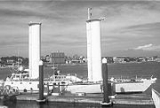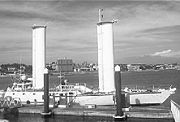
Turbosail
Encyclopedia

Concept
In 1980, Jacques CousteauJacques-Yves Cousteau
Jacques-Yves Cousteau was a French naval officer, explorer, ecologist, filmmaker, innovator, scientist, photographer, author and researcher who studied the sea and all forms of life in water...
dreamed of creating a ship with a modern engine that would be powered, at least in part, by the wind, a clean, free, renewable energy source. The idea of using a hollow, rotating metal cylinder for propulsion, the Flettner rotor, had been tried and discarded decades before Cousteau and a team of engineers decided to revive and improve on it.
Aerodynamics
Cousteau and his associates, Professor Lucien Malavard and Dr. Bertrand Charrier, used a fixed cylinder that looked like a smokestack and functioned like an airplane wing.It consists of an airfoil
Airfoil
An airfoil or aerofoil is the shape of a wing or blade or sail as seen in cross-section....
, vertical and grossly ovoidal tube, with a mobile flap which improves the separation between the intrados and extrados. An aspiration
Aspiration
Aspiration may refer to:In linguistics:*Aspirated consonant, a plosive pronounced with a strong burst of air*Debuccalization, the conversion of a consonant to [h] or [ʔ]*Voiceless glottal fricative In engine technology:...
system pulls air into the tubes, and is used to create an important depression on one side of the sail; propulsion occurs perpendicularly to the pressure. In this way, the "sails" act as wing
Wing
A wing is an appendage with a surface that produces lift for flight or propulsion through the atmosphere, or through another gaseous or liquid fluid...
s, with air moving slower on one side, creating drag.
A movable shutter and system of fan-drawn aspiration improved the efficiency of this new sail. Small-scale models tested in a wind tunnel functioned perfectly, and the Turbosail was born.
As a result of this design, the turbosail gains its most unique characteristic: thrust is available for the direction of travel, regardless of wind direction. A ship equipped with turbosails can make headway even into a headwind, gaining energy from differential pressure created by the captive vortex both inside and outside the sail.
Standard engines can then be used in conjunction with the turbosails. These in turn can be coordinated with computers to control the angles, suction power, and rotation of the sails.
Engineering analysis
When compared to the thrust coefficient of the best sails ever built (Marconi or square types, i.e. ships of the America's Cup or the Japanese wind propulsion system) that of the Turbosail is 3.5 to 4 times superior and gives the system a unique advantage for the economical propulsion. This figure is the result of research on the Alcyone.The efficiency of the system has however not been subjected to sufficient comparative engineering research. There have been only two turbosail equipped vessels on which active research has been performed. The Cousteau group is the only organisation with a large body of data available on turbosails.
The Alcyone reported a 1/3 fuel savings, and a larger commercial vessel had a 15% increase in fuel efficiency over a three year study (see "external links" for references).
The system bears similarities with Anton Flettner
Anton Flettner
Anton Flettner was a German aviation engineer and inventor. He made important contributions to airplane and helicopter design...
's Rotorschiff
Flettner ship
A rotor ship, or Flettner ship, is a ship designed to use the Magnus effect for propulsion. To take advantage of this effect, it uses rotorsails which are powered by an engine. The Magnus effect is a force acting on a spinning body in a moving airstream, which acts perpendicularly to the direction...
, a different design based on the Magnus effect
Magnus effect
The Magnus effect is the phenomenon whereby a spinning object flying in a fluid creates a whirlpool of fluid around itself, and experiences a force perpendicular to the line of motion...
.
Early development 1981-1982 : Moulin à Vent
Cousteau and his research team mounted the invention on a catamaran christened Moulin à Vent (Windmill). Cousteau and his colleagues validated the system by sailing from Tangier to New York. The crossing was nearly complete when, not far from the American shore, they ran into winds of more than 50 knots. The soldering that held the Turbosail in place gave way and the prototype fell into the sea.The system consisted of a single turbosail mast, painted a navy blue. The research program for this vessel was designed to test efficiency of thrust with the propulsive system. While the turbosail did generate thrust and power, they were less than those of the sails and generator set which it replaced. Structural problems on the prototype turbosail resulted in buckling of structure, as well as mechanical sheer fatigue cracks at the base of the sail, reducing the effectiveness of the sail quite dramatically. Having proved the concept, the prototype development was ultimately abandoned in 1982 as Cousteau's group turned their attention to a larger vessel, the Alcyone.
The Alcyone
Cousteau's experience was turned to good use in designing a new vessel. Working with naval engineers, he designed an innovative hull of aluminum, both lightweight and strong. The catamaran-like stern gave it stability. The monohull forward was designed to split swells and improve ride in heavy seas. Two Turbosails rose from her deck and two diesel engines provided the necessary suction forces. The ship was named Alcyone, the daughter of the wind.When the Alcyone was launched in 1985, it benefited from the development of the original turbosail Moulin a Vent. With two turbosails of reduced aspect ratio, the stresses placed on the metal of the sail surfaces was much reduced. Both sails also contained axial turbines for power generation, and with decreases in the cost of computers, also featured sensor driven controls to actuate the sails for optimal thrust.
Practical experience with the ship saw the Cousteau group adopting the vessel as flagship and primary research platform in the 1980s. Computers optimized the functioning of Turbosails and engines. To maintain a constant speed, the engines take over automatically when the wind dies down, and they stop completely when the wind is of sufficient strength when blowing in the right direction. A crew of five is required to maintain the ship.
The Alcyone thus traveled around the world, gaining data about the turbosail's performance in varying wind and weather conditions - in all cases proving the concept and finding the propulsive potential to be very good.

